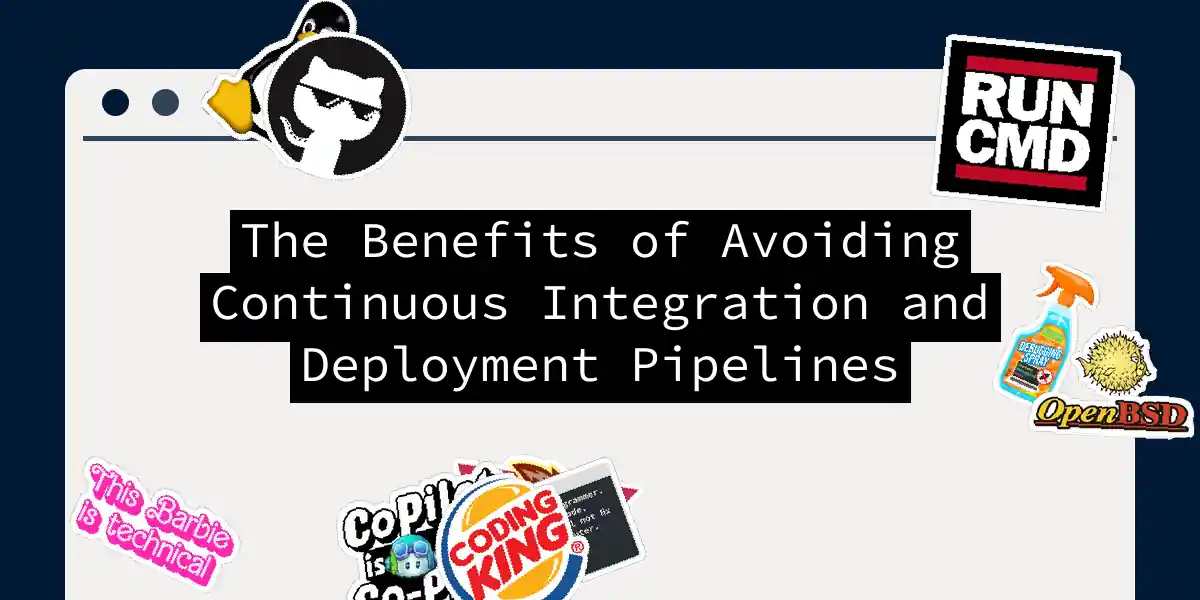The Dark Side of CI/CD: Why You Might Want to Think Twice
In the world of software development, Continuous Integration (CI) and Continuous Deployment (CD) have become the holy grail of efficiency and speed. However, like any powerful tool, they come with their own set of challenges and potential drawbacks. Let’s delve into the often-overlooked side of the coin and explore why avoiding CI/CD pipelines might be the right choice for some teams.
The Complexity of Setup and Maintenance
Setting up a CI/CD pipeline is not a trivial task. It requires a significant investment of time and resources, especially if you’re new to the game. You need to configure your CI server, write scripts for automated testing, and ensure that your deployment process is seamless. This complexity can be overwhelming, especially for smaller teams or projects with limited resources.
The Cost of Automation
While automation is a key benefit of CI/CD, it also comes with a cost. You need to maintain your CI server, update your scripts, and ensure that your automated tests are always relevant. This ongoing maintenance can be costly, both in terms of time and money. For smaller projects or those with limited budgets, the cost of maintaining a CI/CD pipeline might outweigh the benefits[1][3].
The Risk of Over-Automation
Automation is great, but over-automation can lead to a lack of human oversight. In a fully automated CI/CD pipeline, every change that passes the automated tests is deployed to production without human intervention. While this sounds efficient, it also means that any mistake that slips through the tests can end up in production, potentially causing significant issues[4].
The Pressure of Continuous Delivery
Continuous delivery and deployment can create a culture of constant change, which can be both a blessing and a curse. On one hand, it allows for rapid feedback and quicker delivery of features. On the other hand, it can create a high-pressure environment where developers feel like they’re on a never-ending treadmill. This can lead to burnout and decreased job satisfaction.
The Importance of Human Judgment
While automated tests are powerful, they can’t replace human judgment entirely. There are times when a change might pass all the automated tests but still have unintended consequences in production. Human intervention can catch these issues before they become major problems. By avoiding full automation, you ensure that a pair of human eyes reviews each change before it goes live.
The Simplicity of Manual Deployments
For smaller projects or those with simple deployment processes, manual deployments might be more straightforward and less error-prone. Manual deployments allow for a more controlled environment where each step is carefully executed and reviewed. This can be particularly beneficial in environments where the stakes are high, and the margin for error is low.
Security Concerns
CI/CD pipelines involve a lot of moving parts, including third-party components, secrets, and identities. This complexity increases the attack surface, making your pipeline more vulnerable to security breaches. By avoiding CI/CD, you reduce the number of potential entry points for attackers[5].
Conclusion
While CI/CD pipelines are undoubtedly powerful tools for modern software development, they are not a one-size-fits-all solution. For some teams, the benefits of avoiding these pipelines might outweigh the advantages. Whether it’s the complexity of setup, the cost of maintenance, or the risk of over-automation, there are valid reasons to reconsider the adoption of CI/CD.
In the end, it’s about finding the right balance between efficiency, security, and human oversight. So, the next time you’re tempted to jump on the CI/CD bandwagon, take a step back and ask yourself: “Is this really what my team needs?” Because sometimes, the old ways are still the best.
